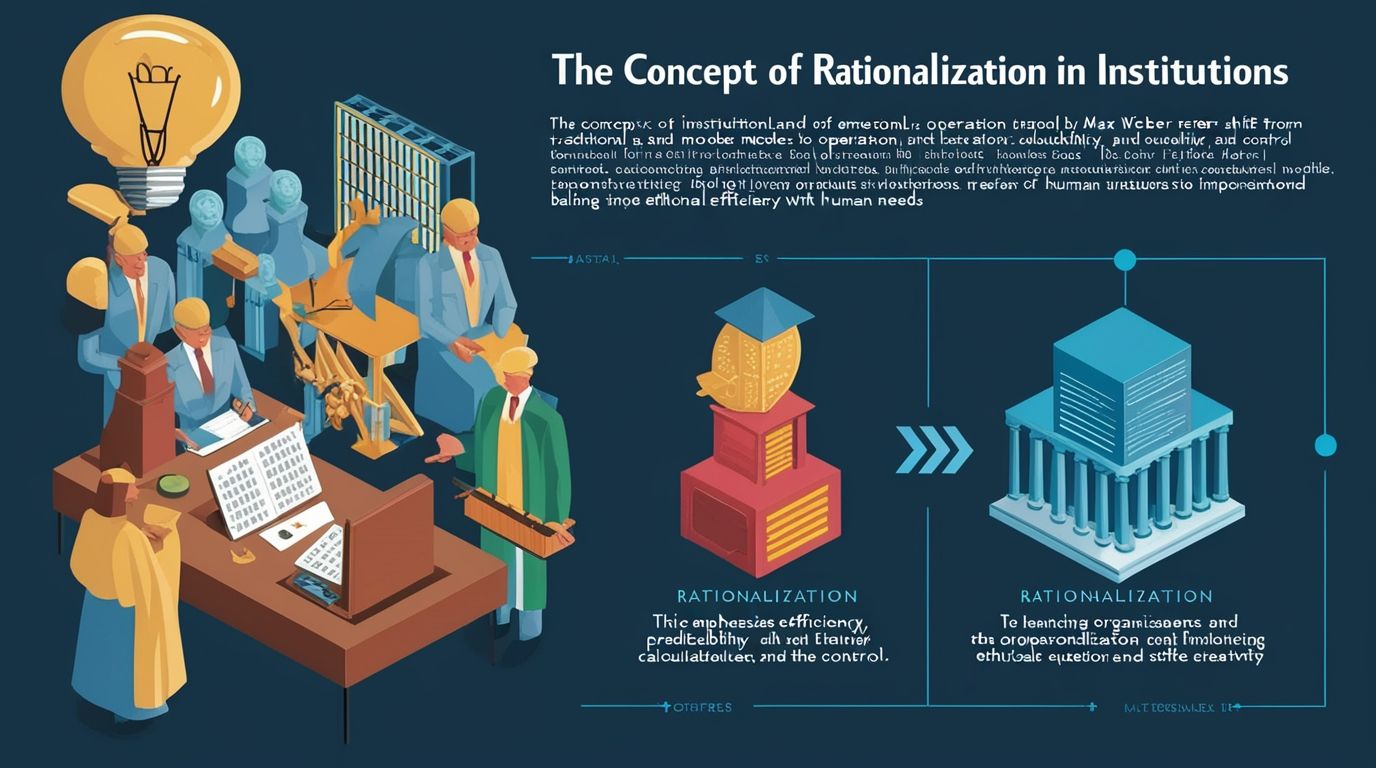Introduction
Rationalization, a concept introduced by Max Weber, is central to understanding the transformation of modern institutions. It describes the shift from traditional ways of thinking, often rooted in superstition, emotion, or custom, toward methods that are systematic, calculated, and efficiency-driven. In institutional contexts, rationalization prioritizes efficiency, predictability, calculability, and control, relying on logic and empirical evidence instead of tradition or personal authority. This article examines the historical origins of rationalization, its key components, its impact across sectors, criticisms, and broader implications for contemporary society.
Historical Roots of Rationalization
The roots of rationalization can be traced to the Enlightenment of the 18th century, when philosophers and scientists like René Descartes, John Locke, and Isaac Newton promoted reason, evidence, and scientific inquiry over tradition. Yet, it was Max Weber in the late 19th and early 20th centuries who gave rationalization a clear sociological meaning.
Weber sought to explain how Western societies transitioned from systems dominated by tradition and charismatic authority to structures governed by rational-legal authority. In The Protestant Ethic and the Spirit of Capitalism, he argued that Protestant values, particularly Calvinist discipline, encouraged rational, systematic work habits that supported the growth of capitalism. Beyond economics, Weber saw rationalization shaping politics, law, education, and religion.
For Weber, bureaucracy was the ultimate embodiment of rationalization. Bureaucracies replaced personal rule with formalized structures based on rules, hierarchies, and procedures. These systems enabled organizations to operate with consistency and efficiency, laying the foundation for modern institutions.
Key Components of Rationalization
Rationalization manifests through four interrelated components visible across sectors like government, business, healthcare, and education:
1. Efficiency:
Institutions pursue the most effective means of achieving goals, often through standardized processes and mechanized systems. Efficiency reduces waste and ensures maximum output with minimal input. For instance, industries use automation to streamline production and cut costs.
2. Predictability:
Consistency is vital to rationalized systems. Standardized procedures guarantee uniform outcomes, minimizing uncertainty. Fast-food chains such as McDonald’s illustrate this principle, offering identical experiences worldwide by relying on carefully rationalized operations.
3. Calculability:
Success is often measured numerically—profits, test scores, patient throughput, or production quotas. While this focus allows for clear evaluation, it often emphasizes quantity over quality. In education, for example, standardized tests reduce learning to numerical results that may overlook creativity or deeper understanding.
4. Control:
Institutions regulate individuals’ actions to maintain consistency. Rules, surveillance systems, and technological tools minimize human error and ensure conformity. From portioning machines in fast-food outlets to performance-monitoring software in workplaces, control underpins rationalization’s emphasis on order and reliability.
Rationalization Across Institutional Sectors
Government and Bureaucracy:
Modern governments rely on bureaucratic structures to administer services such as healthcare, education, and transportation. Decisions follow rational-legal authority grounded in laws and rules rather than tradition or charisma. While bureaucracy ensures consistency, critics argue it can become rigid, impersonal, and inefficient.
Education:
Rationalization in education is visible in standardized testing, unified curricula, and evaluation systems. Students and teachers are often assessed numerically, with success defined by measurable outcomes. This creates efficiency but risks neglecting creativity, individuality, and holistic development.
Healthcare:
Hospitals and clinics increasingly function through standardized protocols, treatment plans, and cost-control strategies. While this improves accessibility and system organization, it often reduces patients to cases to be processed. Calculability dominates, with outcomes measured by statistics such as survival rates or daily patient counts, sometimes at the expense of personalized care.
Corporations and Workplaces:
Rationalization is most prominent in business and industry. Management models like Taylorism and Fordism streamlined tasks into repetitive, efficient routines. Today, automation and artificial intelligence extend rationalization, replacing human labor with faster, more reliable machines. Though this boosts productivity, it also sparks concerns about worker alienation, creativity loss, and unemployment.
Criticism of Rationalization
Despite its benefits, rationalization attracts significant criticism. A primary concern is dehumanization. Individuals become mere numbers or functions, stripped of personal identity within bureaucracies. This alienation leads to disconnection from work, peers, and society.
Another issue is the sacrifice of quality for efficiency. In education, “teaching to the test” narrows learning to test preparation, while in healthcare, doctors may rush patients through appointments to meet quotas.
Rationalization also fosters rigidity. Strict procedures discourage creativity and innovation, leaving organizations slow to adapt. Bureaucratic resistance to change often stifles progress.
Finally, the drive for control may lead to surveillance and micromanagement. Constant monitoring creates anxiety and distrust, while excessive regulation can erode personal freedoms.
Implications for Modern Society
Rationalization has profoundly shaped modern life, enabling technological advancement, economic growth, and efficient mass organization of services. It allows societies to coordinate large-scale institutions and deliver resources to millions.
Yet, the dominance of rationalization raises ethical and social questions. Should efficiency and calculability always outweigh human dignity, creativity, or individuality? As rationalization spreads through technology and globalization, balancing institutional efficiency with human values becomes increasingly urgent.
Conclusion
Rationalization remains one of the most powerful forces shaping institutions. Rooted in Weber’s analysis, it explains how modern systems prioritize efficiency, predictability, calculability, and control. While these qualities ensure order and progress, they also risk dehumanization, rigidity, and loss of creativity. To sustain a balanced society, institutions must recognize both the strengths and limitations of rationalization, ensuring that efficiency serves humanity rather than diminishing it.

9 thoughts on “The Concept of Rationalization in Institutions”
Comments are closed.